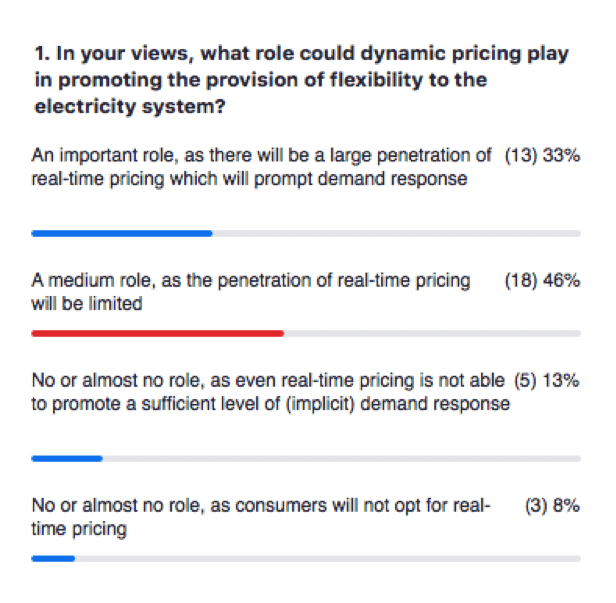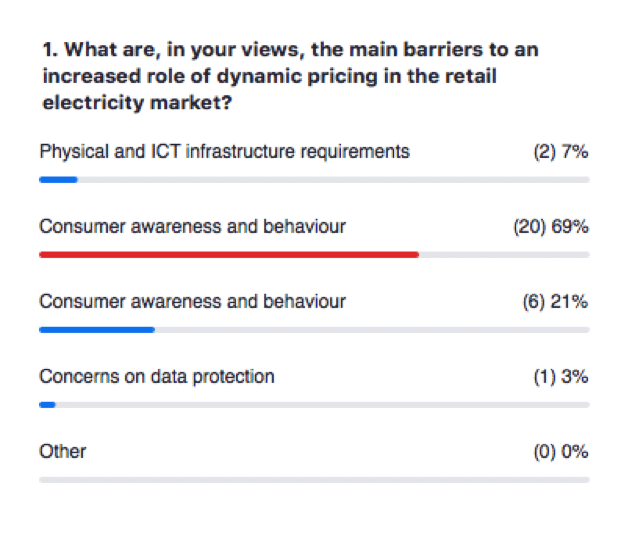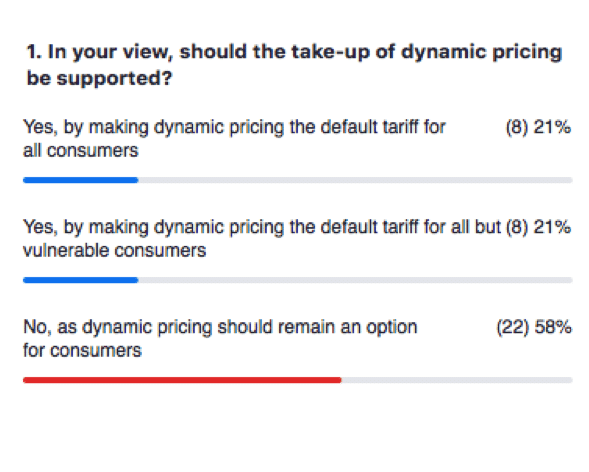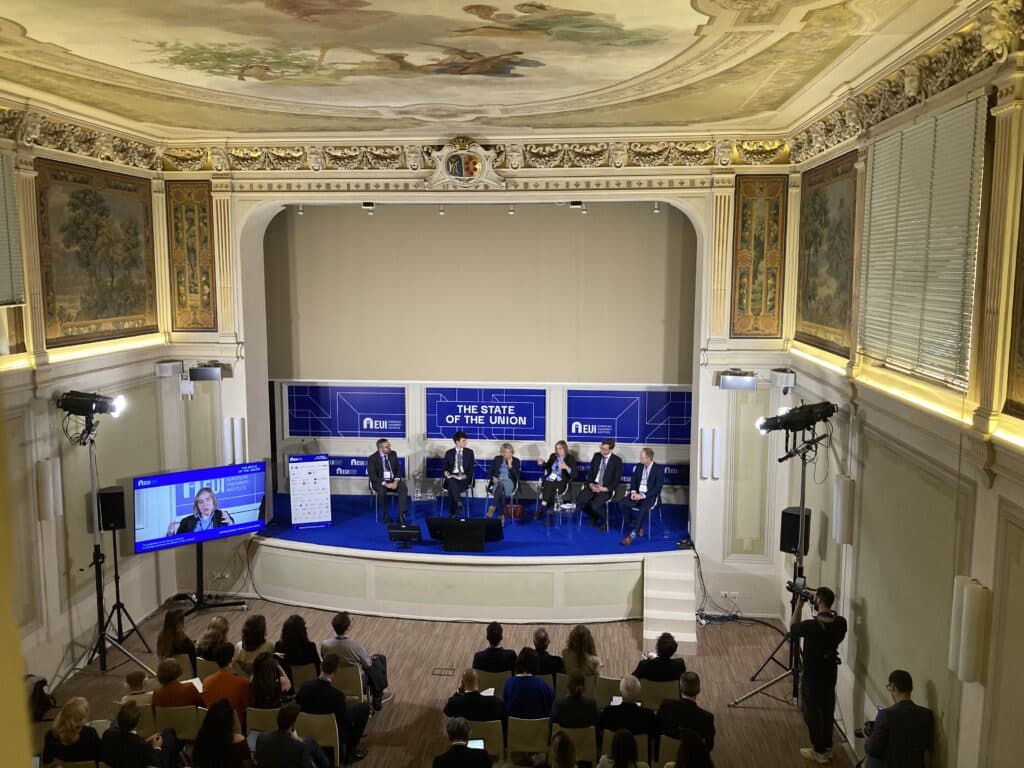Dynamic prices in retail electricity: a way to implement the Energy Efficiency First approach
Highlights from the debate " Dynamic pricing in the electricity retail market"
This #FSRDebate aimed at reviewing the experience with the implementation of dynamic price contracts and their ability to benefit both consumers and the system. The Clean Energy Package introduced provisions[1] entitling all final customers who have a smart meter to conclude a dynamic electricity price contract with at least one supplier in their market and with every supplier that has more than 200,000 final customers.
Dynamic prices benefit both the consumers and the electricity system. The former are able to reduce their electricity bills by managing and adjusting their consumption, in response to price signals. The latter will benefit from (implicit) demand response triggered by high prices, thus potentially reducing the need for additional investment in generation and networks. In this context, the Debate aimed at discussing: (i) to which extent consumers have taken up dynamic price contracts; (ii) the impact of dynamic price contracts on the consumption pattern of consumers; and (iii) which elements of the regulatory framework are key for supporting the penetration of dynamic price contracts.
The Debate was hosted by Leigh Hancher (FSR). After a brief introduction by Alberto Pototschnig (FSR), who moderated the Debate, Adela Tesarova (DG ENER, EC) illustrated the provisions related to dynamic tariffs introduced by the recast of the Electricity Regulation as part of the Clean Energy Package. The Green Deal set more ambitious decarbonisation objectives for the EU, with more renewables in the electricity market. We expect that by 2030, half of the electricity in the EU will be produced from renewables. The transition to a carbon-neutral economy implies profound changes in the way in which the EU produces, transports and consumes energy. Over the next ten years, energy systems are going to be more decentralised, decarbonised and digitalised. We also expect more consumers to be active in the energy market, by self-producing and selling and/or storing electricity. To prepare for this transition, the Clean Energy Package promotes flexibility, including thought dynamic pricing and the role of aggregators in harnessing demand response. Deployment of smart meters is a pre-condition for dynamic price contracting, while it is essential that consumers are well informed about this type of contracts, which should remain voluntary, and more broadly about the new energy sector opportunities, and remain protected, including from excessive prices, without hampering price fluctuations which are the essence of dynamic pricing. The Electricity Directive also provides for dynamic price contracts to be included in the online comparison tools. Ms Tesarova concluded that dynamic price contracts are a very important type of new services appearing in the electricity market, at a time of an increasing penetration of variable renewables and of the need of greater flexibility in the system which consumers might contribute to provide through demand response. The Commission counts on Regulators to assist in monitoring the growth in dynamic price contracts, in identifying any associated risk and in dealing with abusive practices.
After Ms Tesarova’s opening presentation, Anne Vadasz Nilsson (CEER) provided the regulatory perspective on dynamic pricing. She highlighted the importance of correct price signals reaching consumers. The energy system is undergoing a significant transformation, and consumers can contribute to system flexibility. The foreseen increase in electricity demand due to electrification will exacerbate constraints in the network. Demand response, especially in the household sector, could play a very important role in addressing these constraints. But there are significant challenges before demand response can exert its full potential: the deployment of smart meters with the appropriate functionalities; increasing the interest of retailers in promoting dynamic price contracts; facilitating the comparison of dynamic price offers, with comparison tool needing to include and properly deal with such offers; the establishment of a level playing field for incumbents and new entrants; and the removal of price regulation. We also need well-design rules for independent aggregators, being r responsible for imbalances, without over-regulating. Finally, it is essential to inform and protect consumers, avoiding information overload. And perhaps to promote the installation of optimisation equipment which could help consumers to make the most of the flexibility they can provide.
Gema Rico Rivas (CNMC), Jaume Loffredo (BEUC), Alain Taccoen (Eurelectric) and Roberto Zangrandi (EDSO) animated the ensuing panel debate.
Gema Rico Rivas illustrated the Spanish experience. Since 2014, household consumers with contracted power below 10KW can choose between a dynamic price contract offered by the reference supplier (spot price plus ancillary services price) and regular supply in the free market. The reference supplier shall also offer an unregulated fixed-price annual contract. More than half of the small consumers in Spain have opted for dynamic price contracts. Switching rate for domestic consumers is around 9%. These consumers tend to prefer time-variable tariffs, but no significant change in the consumption pattern has been noticed. Ms Rico Rivas then referred to a number of initiatives of CNMC to engage consumers in the energy retail market: amending the distribution tariff design, the establishment of three metering time periods (peak, standard and valley), the promotion of energy efficiency. CNMC has also published a number of recommendations for consumers and retailers and a new billing design, and released a billing calculator.
Jaume Loffredo stressed the importance of implementing the Clean Energy Package properly in order to achieve the EU environmental objectives. Dynamic price contracts have a key role in this context. BEUC regrets that the provisions on dynamic pricing in the Clean Energy Package are not yet implemented in many Member States. On the consumer perspective, BEUC observes two trends: (i) countries where dynamic price contracts have been available for a few years and where consumers have been opting for these contracts and they gained experience with them; (ii) other markets where dynamic price contracts have only been recently introduced and where consumers are still sceptical and more information is needed. There is therefore potential for a greater role of dynamic price contracts, but this rests on three aspects: tangible savings being perceived by consumers; clear information on price dynamics and the impact on consumers; and contractual clauses protecting consumers from the risk of excessive prices.
Alain Taccoen opened his statement by highlighting that dynamic prices might be a risky business, as the experience in Texas has shown. However, there is a positive role for dynamic prices, as, in the long run, they are shown to reduce the consumers’ bill. Eurelectric believes that consumers and domestic demand flexibility are key for the success of EU decarbonisation strategy. However, many appliances are not yet connected to smart meters/internet, which would be required to activate the full flexibility capacity of domestic consumers. However, final energy bills contain also network tariffs and taxes. Eurelectric does not favour dynamic network tariffs. Finally increasing taxes and levies will hamper the increase electrification of the economy.
Roberto Zangrandi agreed with most reflections offered by the other panellists, including the need to facilitate the consumers in taking advantage of dynamic prices. We ask customer to be responsive, to be prosumers, we expect them to make good use of beyond-the-meter storage, to participate in the electrification of transport and to provide the storage capacity of cars to the market, and we ask consumers to be ready to go for peer-to-peer exchanges. This is a significant burden for consumers, which would need to be prompted by appropriate price signals. However, at present, the commodity share in the final bill is approximately a third of the total bill. When developing flexibility at local level, it is important to consider the connection with the other parts of the market and the structure of the distribution network tariffs, which should provide the proper economic signals to network users, not to be subject to market objectives and be resilient and anticipate future challenges. In this respect, EDSO proposes a few guiding principles for distribution network tariff structure: cost reflectivity, fairness, efficiency, non-discrimination, transparency and limited complexity. EDSO is also concerned by the possible proliferation of “compensatory” services, which will be a substantial breach of the social role of a public service.
After a first round of contributions from panellists, three polls were used to collect views from the general audience. The first question asked participants about their views on the role that dynamic pricing could play in promoting the provision of flexibility to the electricity system.

The majority of respondents expect a medium role for dynamic pricing in the provision of flexibility, as the penetration of real-time pricing will be limited for some times to come.
The second poll asked participants about the main barriers to an increased role of dynamic pricing in the retail electricity market.

The majority of respondents identified consumer awareness and behaviour as the main barrier.
The third poll explored whether the take-up of dynamic pricing should be supported.

The majority of respondents clearly believes that dynamic prices should not become the default tariff, but should instead be provided as an opt-in alternative.
The panellists and speakers of the opening part of the Debate then commented on the results of the polls and addressed a few specific questions from the audience.
[1] Article 11 of Directive (EU) 2019/944.







